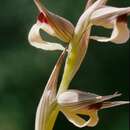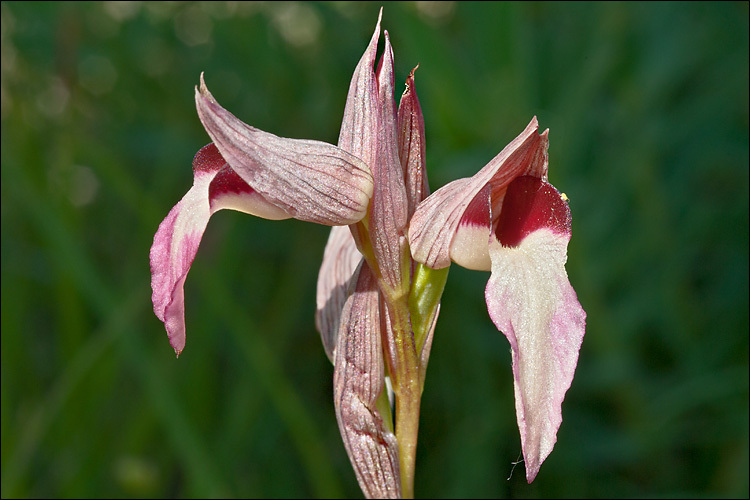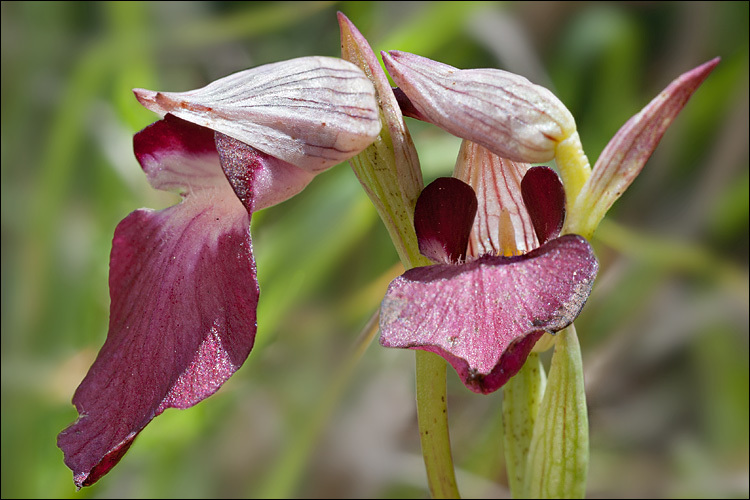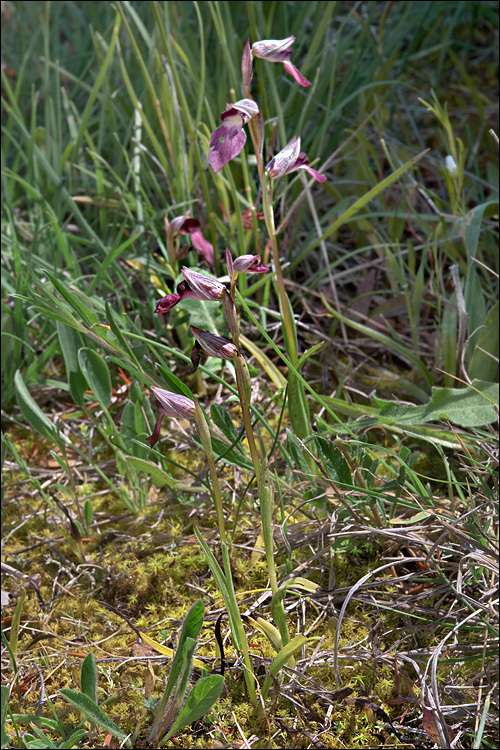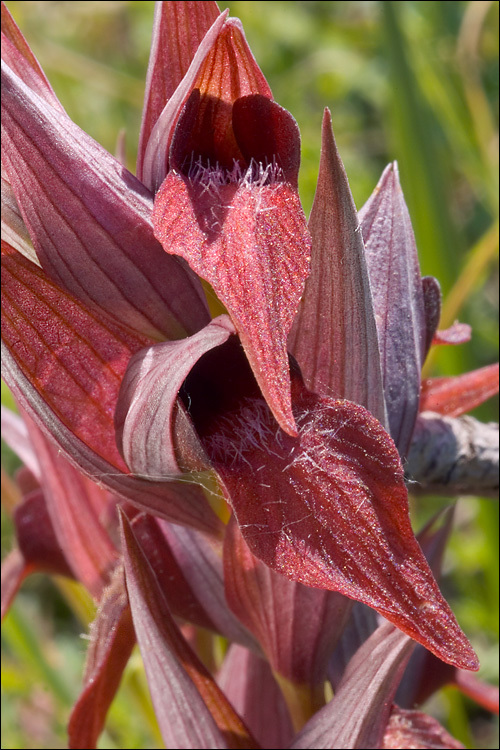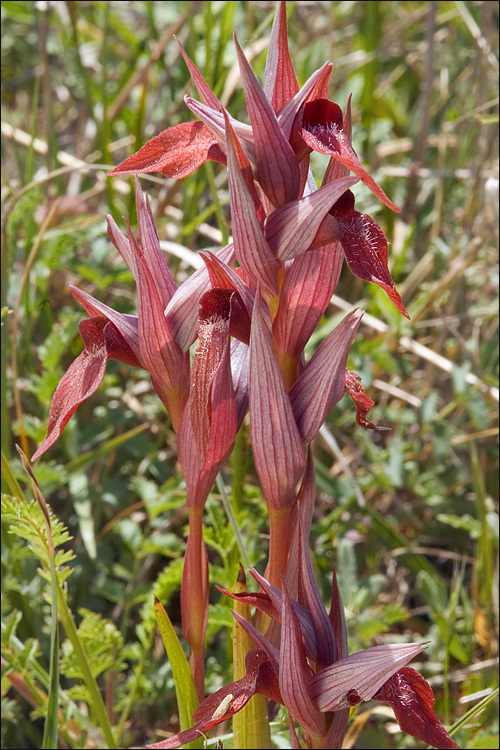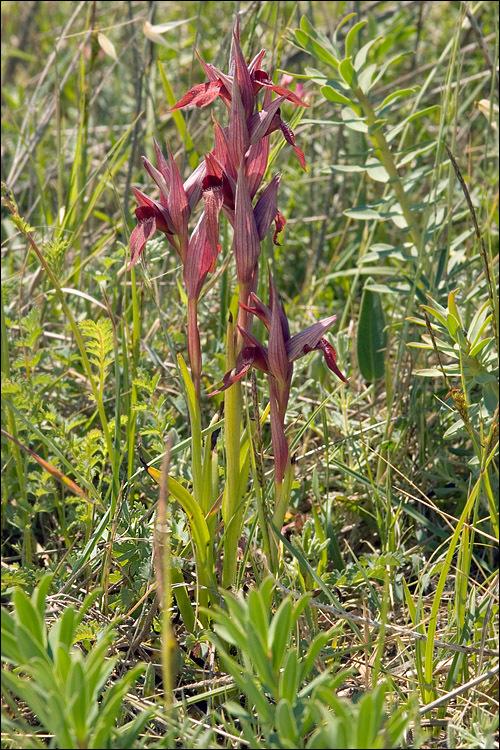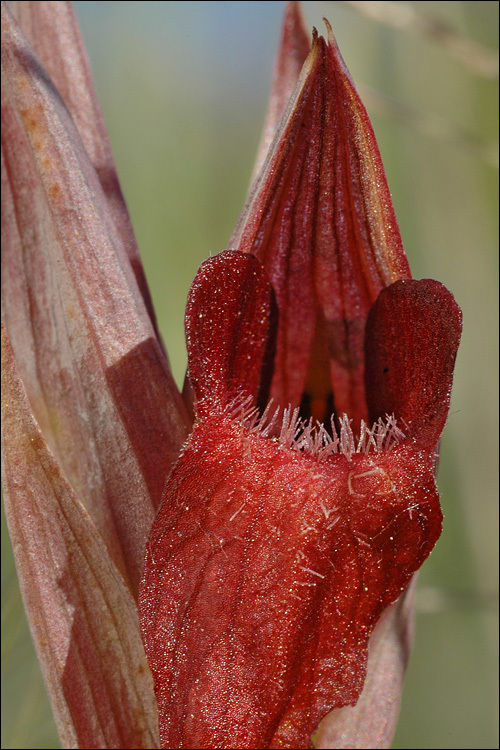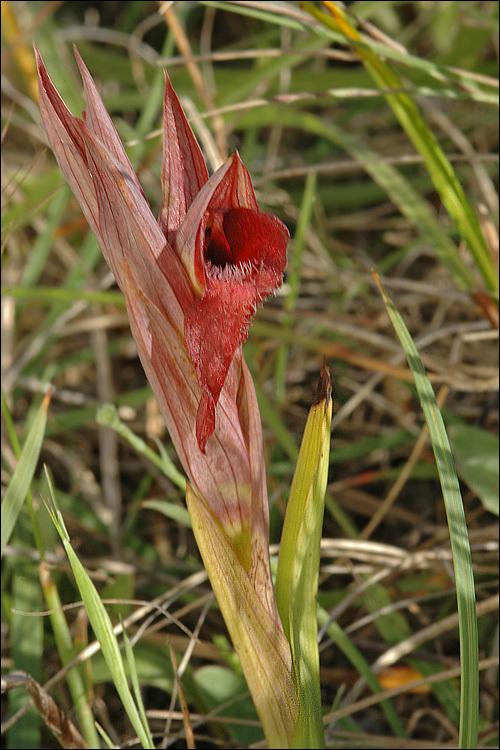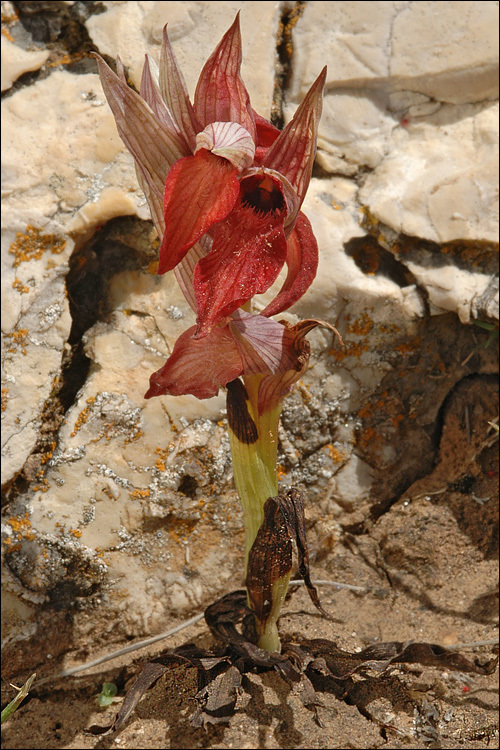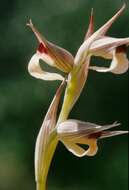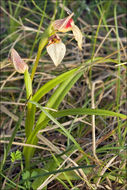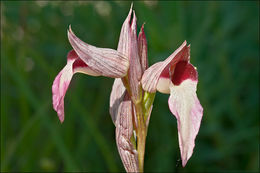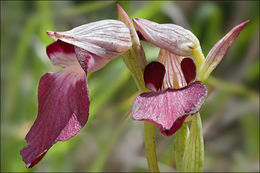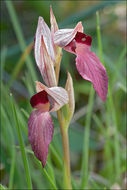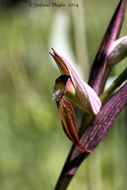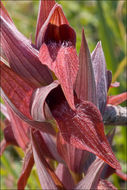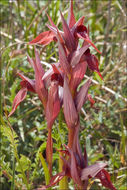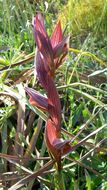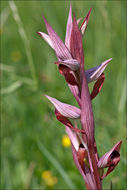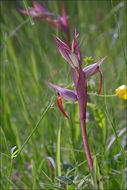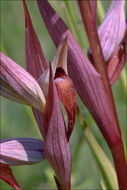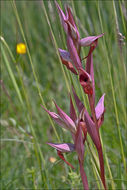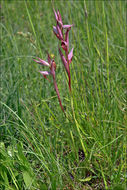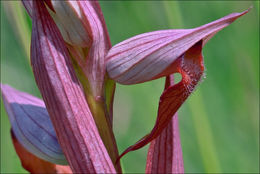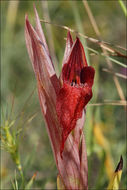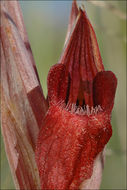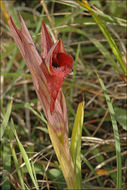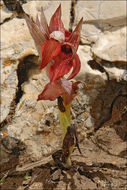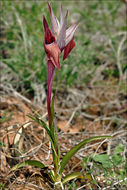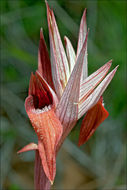-
Kreta, Grækenland
-
Kreta, Grækenland
-
CRO.: jezicasta kukavica
-
CR.: jezičasta kukavica - Habitat: dry grassland, among bushes, flat terrain, full sun, exposed to direct rain, average precipitations 800-900 mm/year, average temperature 13-14 deg C, elevation 30 m (100 feet, sub-Mediterranean phytogeographical region. - Substratum: soil. - Comment: Growing in groups, many plants. - Protected species according to Zakon o zatiti prirode (Narodne novine, broj 70/05 i 139/08) of Croatia and Pravilnik o proglaavanju divjih svojti zatićenim in strogo zatićenim. - Ref.: (1) R. Domac, Flora Hrvatske (Flora of Croatia) in Croat language, kolska knjiga (1993) p 464. (2) H.Baumann, S. Kuenkele, R.Lorenz, Orchideen Europas, Ulmer (2006), p 281. (3) V. Hrak, S. Brana, Z. Sedlar, I. Pejić, Morphometric and molecular (RAPD) analysis of six Serapias taxa from Croatia, Springer (2011), Biologia, Vol.66, no.1, pp 55-63. (4) N.Vuković. S.Brana, B. Mitić, Orchid diversity of the Kamenjak (Istria, Croatia), (2011), Acta Bot. Croat, vol. 70, no. 1., pp 23-40.
-
CR.: jezičasta kukavica - Habitat: dry grassland, among bushes, flat terrain, full sun, exposed to direct rain, average precipitations 800-900 mm/year, average temperature 13-14 deg C, elevation 30 m (100 feet, sub-Mediterranean phytogeographical region. - Substratum: soil. - Comment: Growing in groups, many plants. - Protected species according to Zakon o zatiti prirode (Narodne novine, broj 70/05 i 139/08) of Croatia and Pravilnik o proglaavanju divjih svojti zatićenim in strogo zatićenim. - Ref.: (1) R. Domac, Flora Hrvatske (Flora of Croatia) in Croat language, kolska knjiga (1993) p 464. (2) H.Baumann, S. Kuenkele, R.Lorenz, Orchideen Europas, Ulmer (2006), p 281. (3) V. Hrak, S. Brana, Z. Sedlar, I. Pejić, Morphometric and molecular (RAPD) analysis of six Serapias taxa from Croatia, Springer (2011), Biologia, Vol.66, no.1, pp 55-63. (4) N.Vuković. S.Brana, B. Mitić, Orchid diversity of the Kamenjak (Istria, Croatia), (2011), Acta Bot. Croat, vol. 70, no. 1., pp 23-40.
-
CR.: jezičasta kukavica - Habitat: dry grassland, among bushes, flat terrain, full sun, exposed to direct rain, average precipitations 800-900 mm/year, average temperature 13-14 deg C, elevation 30 m (100 feet, sub-Mediterranean phytogeographical region. - Substratum: soil. - Comment: Growing in groups, many plants. - Protected species according to Zakon o zatiti prirode (Narodne novine, broj 70/05 i 139/08) of Croatia and Pravilnik o proglaavanju divjih svojti zatićenim in strogo zatićenim. - Ref.: (1) R. Domac, Flora Hrvatske (Flora of Croatia) in Croat language, kolska knjiga (1993) p 464. (2) H.Baumann, S. Kuenkele, R.Lorenz, Orchideen Europas, Ulmer (2006), p 281. (3) V. Hrak, S. Brana, Z. Sedlar, I. Pejić, Morphometric and molecular (RAPD) analysis of six Serapias taxa from Croatia, Springer (2011), Biologia, Vol.66, no.1, pp 55-63. (4) N.Vuković. S.Brana, B. Mitić, Orchid diversity of the Kamenjak (Istria, Croatia), (2011), Acta Bot. Croat, vol. 70, no. 1., pp 23-40.
-
CR.: jezičasta kukavica - Habitat: dry grassland, among bushes, flat terrain, full sun, exposed to direct rain, average precipitations 800-900 mm/year, average temperature 13-14 deg C, elevation 30 m (100 feet, sub-Mediterranean phytogeographical region. - Substratum: soil. - Comment: Growing in groups, many plants. - Protected species according to Zakon o zatiti prirode (Narodne novine, broj 70/05 i 139/08) of Croatia and Pravilnik o proglaavanju divjih svojti zatićenim in strogo zatićenim. - Ref.: (1) R. Domac, Flora Hrvatske (Flora of Croatia) in Croat language, kolska knjiga (1993) p 464. (2) H.Baumann, S. Kuenkele, R.Lorenz, Orchideen Europas, Ulmer (2006), p 281. (3) V. Hrak, S. Brana, Z. Sedlar, I. Pejić, Morphometric and molecular (RAPD) analysis of six Serapias taxa from Croatia, Springer (2011), Biologia, Vol.66, no.1, pp 55-63. (4) N.Vuković. S.Brana, B. Mitić, Orchid diversity of the Kamenjak (Istria, Croatia), (2011), Acta Bot. Croat, vol. 70, no. 1., pp 23-40.
-
-
Slo.: velecvetni serap, velecvetni ralovec
-
Slo.: velecvetni serap, velecvetni ralovec
-
Slo.: velecvetni serap, velecvetni ralovec
-
-
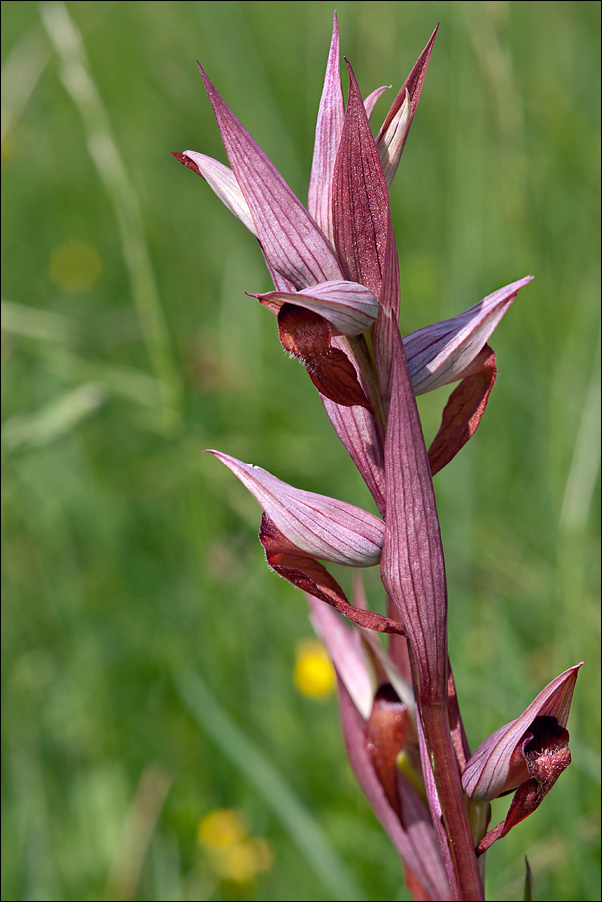
Slo.: velecvetni serap, velecvetni ralovec - Habitat: grassland, on a meadow within broad leafed woods, south oriented hill slope, warm place, dry and sunny place, exposed to direct rain, average precipitations 2.000-2.600 mm/year, average temperature 8-10 deg C, elevation 295 m (970 feet), submediterranean phytogeographical region. - Substratum: soil. - Comment: Plants from the genus Serapias are very distinctly shaped and visually much different from all other members of Orchidaceae family. They are thus very easy to recognize, however, much more difficult to find them in Slovenia. They are truly at home much more south in warm Mediterranean regions. Only one species, namely Serapias vomeracea is known to grow in Slovenia. The place where these pictures were taken is our most northern known, although west of it, in the great plains and hills of Pad river, it spreads more northern entering the Alps in Ticino region in Switzerland and in their southwest regions in Italy. - Enlisted in the Slovene Red List of rare and endangered species, marked by 'V' representing a vulnerable species. - Ref.: (1) Personal communication with Mr. BrankoDolinar, www.orhidejeslovenije.com (2) A. Martini et all., Mala Flora Slovenije, TehninaZalobaSlovenije (2007), p 782. (3) L. Poldini, NuovoAtlantecorologicodellepiantevascolarinel Friuli Venezia Giulia, University of Trieste (2002), p 454. (4) N. Jogan (ed.), Gradivoza Atlas floreSlovenije (Materials for the Atlas of Flora of Slovenia), CKSF (2001), p 352. (5) D. Aeschimann, K. Lauber, D.M. Moser, J.P. Theurillat, Flora Alpina, Vol. 2., Haupt (2004), p 1136.
-
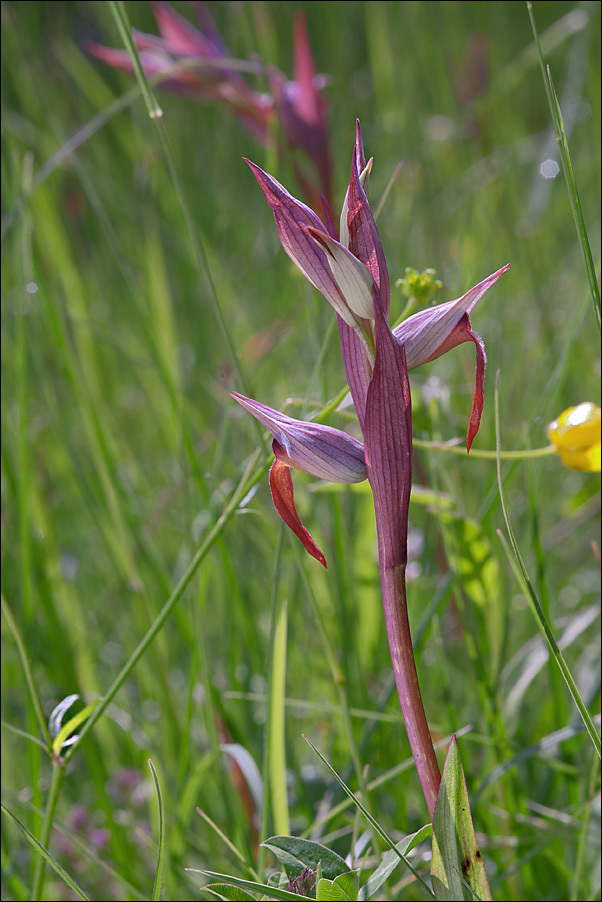
Slo.: velecvetni serap, velecvetni ralovec - Habitat: grassland, on a meadow within broad leafed woods, south oriented hill slope, warm place, dry and sunny place, exposed to direct rain, average precipitations 2.000-2.600 mm/year, average temperature 8-10 deg C, elevation 295 m (970 feet), submediterranean phytogeographical region. - Substratum: soil. - Comment: Plants from the genus Serapias are very distinctly shaped and visually much different from all other members of Orchidaceae family. They are thus very easy to recognize, however, much more difficult to find them in Slovenia. They are truly at home much more south in warm Mediterranean regions. Only one species, namely Serapias vomeracea is known to grow in Slovenia. The place where these pictures were taken is our most northern known, although west of it, in the great plains and hills of Pad river, it spreads more northern entering the Alps in Ticino region in Switzerland and in their southwest regions in Italy. - Enlisted in the Slovene Red List of rare and endangered species, marked by 'V' representing a vulnerable species. - Ref.: (1) Personal communication with Mr. BrankoDolinar, www.orhidejeslovenije.com (2) A. Martini et all., Mala Flora Slovenije, TehninaZalobaSlovenije (2007), p 782. (3) L. Poldini, NuovoAtlantecorologicodellepiantevascolarinel Friuli Venezia Giulia, University of Trieste (2002), p 454. (4) N. Jogan (ed.), Gradivoza Atlas floreSlovenije (Materials for the Atlas of Flora of Slovenia), CKSF (2001), p 352. (5) D. Aeschimann, K. Lauber, D.M. Moser, J.P. Theurillat, Flora Alpina, Vol. 2., Haupt (2004), p 1136.
-
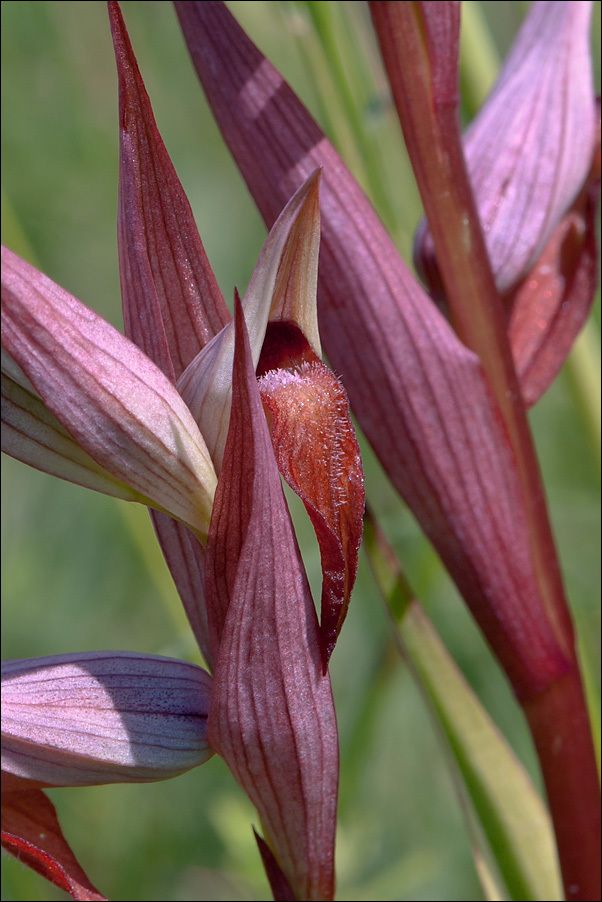
Slo.: velecvetni serap, velecvetni ralovec - Habitat: grassland, on a meadow within broad leafed woods, south oriented hill slope, warm place, dry and sunny place, exposed to direct rain, average precipitations 2.000-2.600 mm/year, average temperature 8-10 deg C, elevation 295 m (970 feet), submediterranean phytogeographical region. - Substratum: soil. - Comment: Plants from the genus Serapias are very distinctly shaped and visually much different from all other members of Orchidaceae family. They are thus very easy to recognize, however, much more difficult to find them in Slovenia. They are truly at home much more south in warm Mediterranean regions. Only one species, namely Serapias vomeracea is known to grow in Slovenia. The place where these pictures were taken is our most northern known, although west of it, in the great plains and hills of Pad river, it spreads more northern entering the Alps in Ticino region in Switzerland and in their southwest regions in Italy. - Enlisted in the Slovene Red List of rare and endangered species, marked by 'V' representing a vulnerable species. - Ref.: (1) Personal communication with Mr. BrankoDolinar, www.orhidejeslovenije.com (2) A. Martini et all., Mala Flora Slovenije, TehninaZalobaSlovenije (2007), p 782. (3) L. Poldini, NuovoAtlantecorologicodellepiantevascolarinel Friuli Venezia Giulia, University of Trieste (2002), p 454. (4) N. Jogan (ed.), Gradivoza Atlas floreSlovenije (Materials for the Atlas of Flora of Slovenia), CKSF (2001), p 352. (5) D. Aeschimann, K. Lauber, D.M. Moser, J.P. Theurillat, Flora Alpina, Vol. 2., Haupt (2004), p 1136.
-
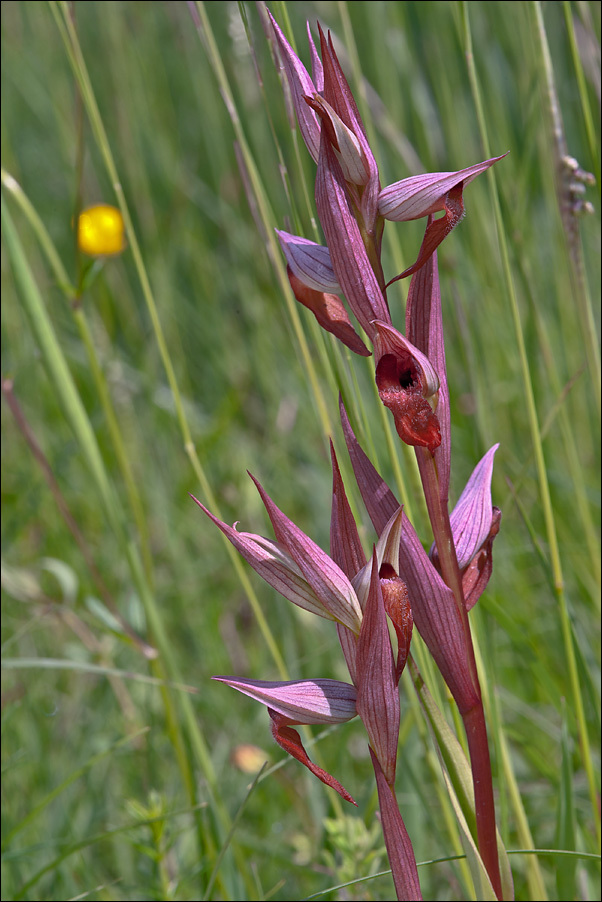
Slo.: velecvetni serap, velecvetni ralovec - Habitat: grassland, on a meadow within broad leafed woods, south oriented hill slope, warm place, dry and sunny place, exposed to direct rain, average precipitations 2.000-2.600 mm/year, average temperature 8-10 deg C, elevation 295 m (970 feet), submediterranean phytogeographical region. - Substratum: soil. - Comment: Plants from the genus Serapias are very distinctly shaped and visually much different from all other members of Orchidaceae family. They are thus very easy to recognize, however, much more difficult to find them in Slovenia. They are truly at home much more south in warm Mediterranean regions. Only one species, namely Serapias vomeracea is known to grow in Slovenia. The place where these pictures were taken is our most northern known, although west of it, in the great plains and hills of Pad river, it spreads more northern entering the Alps in Ticino region in Switzerland and in their southwest regions in Italy. - Enlisted in the Slovene Red List of rare and endangered species, marked by 'V' representing a vulnerable species. - Ref.: (1) Personal communication with Mr. BrankoDolinar, www.orhidejeslovenije.com (2) A. Martini et all., Mala Flora Slovenije, TehninaZalobaSlovenije (2007), p 782. (3) L. Poldini, NuovoAtlantecorologicodellepiantevascolarinel Friuli Venezia Giulia, University of Trieste (2002), p 454. (4) N. Jogan (ed.), Gradivoza Atlas floreSlovenije (Materials for the Atlas of Flora of Slovenia), CKSF (2001), p 352. (5) D. Aeschimann, K. Lauber, D.M. Moser, J.P. Theurillat, Flora Alpina, Vol. 2., Haupt (2004), p 1136.
-

Slo.: velecvetni serap, velecvetni ralovec - Habitat: grassland, on a meadow within broad leafed woods, south oriented hill slope, warm place, dry and sunny place, exposed to direct rain, average precipitations 2.000-2.600 mm/year, average temperature 8-10 deg C, elevation 295 m (970 feet), submediterranean phytogeographical region. - Substratum: soil. - Comment: Plants from the genus Serapias are very distinctly shaped and visually much different from all other members of Orchidaceae family. They are thus very easy to recognize, however, much more difficult to find them in Slovenia. They are truly at home much more south in warm Mediterranean regions. Only one species, namely Serapias vomeracea is known to grow in Slovenia. The place where these pictures were taken is our most northern known, although west of it, in the great plains and hills of Pad river, it spreads more northern entering the Alps in Ticino region in Switzerland and in their southwest regions in Italy. - Enlisted in the Slovene Red List of rare and endangered species, marked by 'V' representing a vulnerable species. - Ref.: (1) Personal communication with Mr. BrankoDolinar, www.orhidejeslovenije.com (2) A. Martini et all., Mala Flora Slovenije, TehninaZalobaSlovenije (2007), p 782. (3) L. Poldini, NuovoAtlantecorologicodellepiantevascolarinel Friuli Venezia Giulia, University of Trieste (2002), p 454. (4) N. Jogan (ed.), Gradivoza Atlas floreSlovenije (Materials for the Atlas of Flora of Slovenia), CKSF (2001), p 352. (5) D. Aeschimann, K. Lauber, D.M. Moser, J.P. Theurillat, Flora Alpina, Vol. 2., Haupt (2004), p 1136.
-
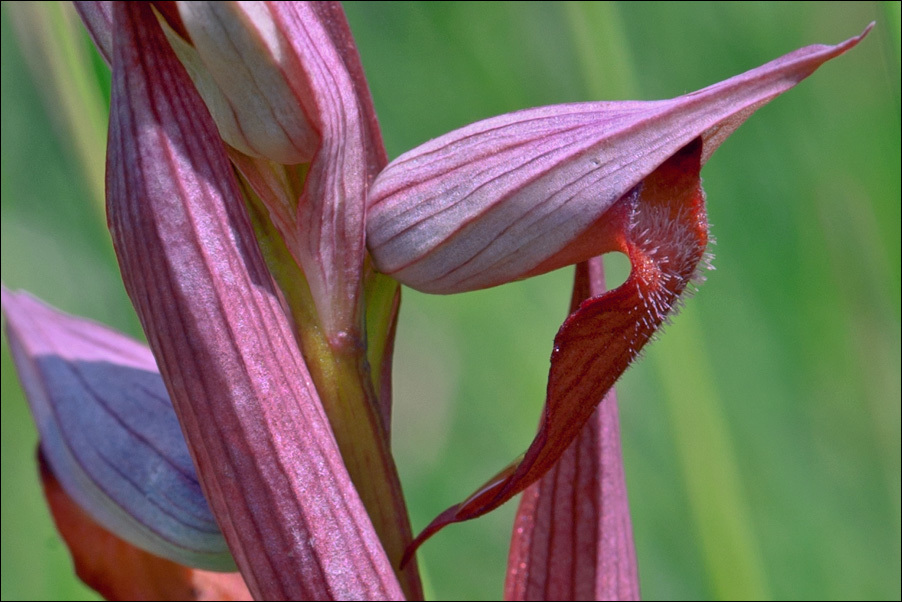
Slo.: velecvetni serap, velecvetni ralovec - Habitat: grassland, on a meadow within broad leafed woods, south oriented hill slope, warm place, dry and sunny place, exposed to direct rain, average precipitations 2.000-2.600 mm/year, average temperature 8-10 deg C, elevation 295 m (970 feet), submediterranean phytogeographical region. - Substratum: soil. - Comment: Plants from the genus Serapias are very distinctly shaped and visually much different from all other members of Orchidaceae family. They are thus very easy to recognize, however, much more difficult to find them in Slovenia. They are truly at home much more south in warm Mediterranean regions. Only one species, namely Serapias vomeracea is known to grow in Slovenia. The place where these pictures were taken is our most northern known, although west of it, in the great plains and hills of Pad river, it spreads more northern entering the Alps in Ticino region in Switzerland and in their southwest regions in Italy. - Enlisted in the Slovene Red List of rare and endangered species, marked by 'V' representing a vulnerable species. - Ref.: (1) Personal communication with Mr. BrankoDolinar, www.orhidejeslovenije.com (2) A. Martini et all., Mala Flora Slovenije, TehninaZalobaSlovenije (2007), p 782. (3) L. Poldini, NuovoAtlantecorologicodellepiantevascolarinel Friuli Venezia Giulia, University of Trieste (2002), p 454. (4) N. Jogan (ed.), Gradivoza Atlas floreSlovenije (Materials for the Atlas of Flora of Slovenia), CKSF (2001), p 352. (5) D. Aeschimann, K. Lauber, D.M. Moser, J.P. Theurillat, Flora Alpina, Vol. 2., Haupt (2004), p 1136.
-
Slo.: istrski serap - Endemic of Istria, rare plant
-
Slo.: istrski serap - Endemic of Istria, rare plant
-
Slo.: istrski serap - Endemic of Istria, rare plant
-
Slo.: istrski serap - Endemic of Istria, rare plant
-
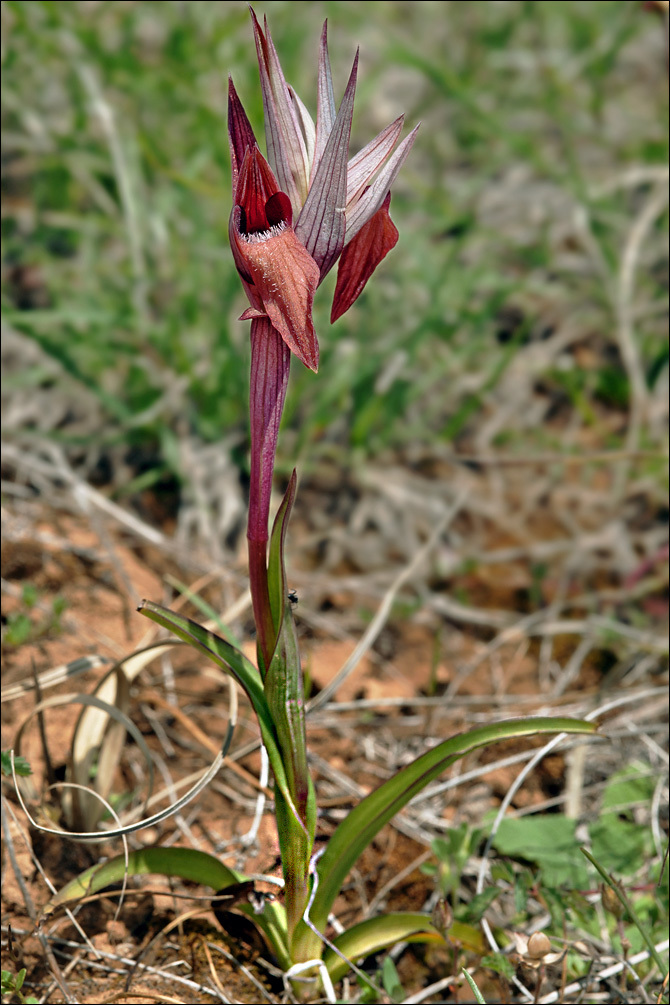
Slo.: istrski ralovec, CR: istarska kukavica - syn.: Serapias neglecta subsp. apulica Landw. - Habitat: : Stony grassland; sandy, skeletal soil, calcareous ground; open, almost flat terrain, full sun, average temperatures 13-14 deg C, average precipitation 800-900 mm/year, elevation 15 m (50 feet), Mediterranean phytogeographical region. Substratum: soil. Comment: Species of the genus Serapias are essentially plants of Mediterranean Sea region. Among them Serapias istriaca represents a rare, narrow-endemic named by Istria peninsula in Croatia, northwest Adriatic sea. Recent morphometric as well as molecular research showed that it is a well-established species (Ref.:2). It flourishes only on south part of Istria peninsula and neighboring island Loinj and on the sea shore of northwest Greece. Species of genus Serapias are strange, almost bizarre looking orchids. To recognize plants of this genus is simple because of their unusual shape of flowers, however, to distinguish them to species level is a much more difficult task. Serapias istriaca doesn't grow in Slovenian Adriatic Sea shore region, so the only our member of this genus remains Serapias vomeraca and also this plant is a rare find in Slovenia. Ref.: (1) http://hirc.botanic.hr/fcd/DetaljiFrame.aspx?IdVrste=27626&taxon=Serapias+istriaca+Perko (2) V. Hrak, S. Brana, Z. Sedlar, I. Peji, Morphometric and molecular (RAPD) analysis of six Serapias taxa from Croatia, J. Biologia, Vol. 66, 1. (2011), pp 55-63. http://link.springer.com/article/10.2478%2Fs11756-010-0132-5
-
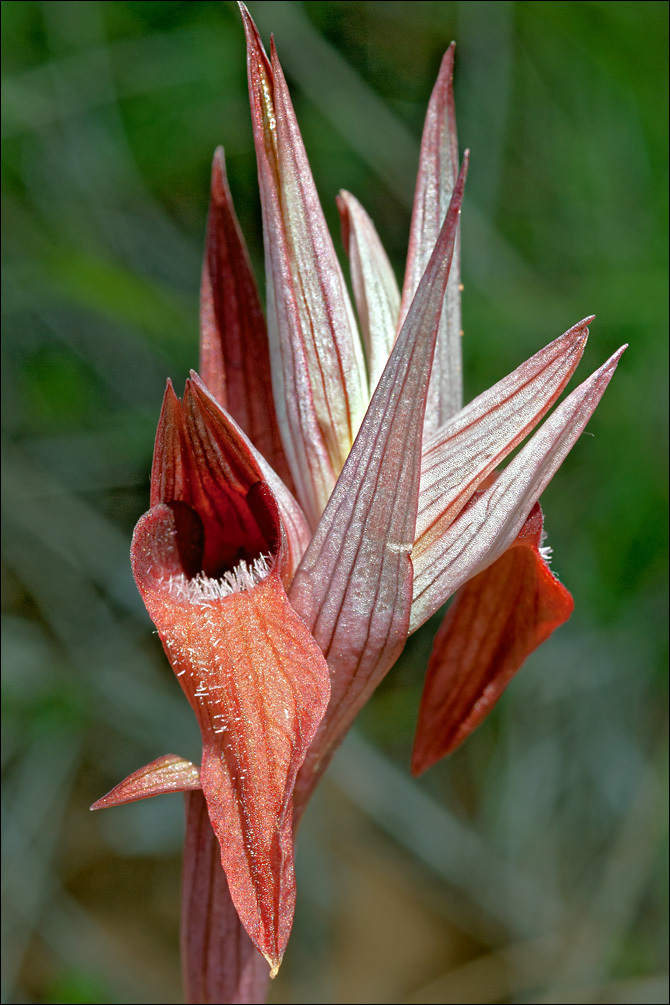
Slo.: istrski ralovec, CR: istarska kukavica - syn.: Serapias neglecta subsp. apulica Landw. - Habitat: : Stony grassland; sandy, skeletal soil, calcareous ground; open, almost flat terrain, full sun, average temperatures 13-14 deg C, average precipitation 800-900 mm/year, elevation 15 m (50 feet), Mediterranean phytogeographical region. Substratum: soil. Comment: Species of the genus Serapias are essentially plants of Mediterranean Sea region. Among them Serapias istriaca represents a rare, narrow-endemic named by Istria peninsula in Croatia, northwest Adriatic sea. Recent morphometric as well as molecular research showed that it is a well-established species (Ref.:2). It flourishes only on south part of Istria peninsula and neighboring island Loinj and on the sea shore of northwest Greece. Species of genus Serapias are strange, almost bizarre looking orchids. To recognize plants of this genus is simple because of their unusual shape of flowers, however, to distinguish them to species level is a much more difficult task. Serapias istriaca doesn't grow in Slovenian Adriatic Sea shore region, so the only our member of this genus remains Serapias vomeraca and also this plant is a rare find in Slovenia. Ref.: (1) http://hirc.botanic.hr/fcd/DetaljiFrame.aspx?IdVrste=27626&taxon=Serapias+istriaca+Perko (2) V. Hrak, S. Brana, Z. Sedlar, I. Peji, Morphometric and molecular (RAPD) analysis of six Serapias taxa from Croatia, J. Biologia, Vol. 66, 1. (2011), pp 55-63. http://link.springer.com/article/10.2478%2Fs11756-010-0132-5

